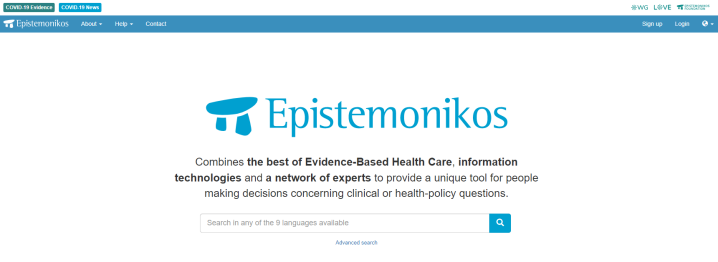
Systematic reviews, more broadly, evidence syntheses, collect and synthesize primary evidence in healthcare. Not only do these comprehensive documents save medical professionals’ time, they can also provide a higher level of evidence than individual studies do on their own. However, the sheer number of evidence syntheses (meta-analyses, systematic reviews, scoping reviews, rapid reviews, and more) published each year is beginning to render these time saving resources unmanageable. A simple search for epilepsy and cannabinoids on PubMed, limited to Systematic Reviews or Meta-Analysis, yields 37 results, 34 of which have been published in the last 5 years (since 2017).
What is Epistimonikos?
The Epistimonikos Database, the flagship project of the Epistimonikos Foundation, is a freely available index of systematic reviews, overviews of reviews, and primary studies cited in those reviews. In the Foundation’s own words, “A unique feature of Epistemonikos is that it links together systematic reviews, overviews of reviews and primary studies, thus providing a highly efficient method for searching.” Not only does Epistimonikos locate and index evidence syntheses on healthcare topics, it links reviews that include the same studies, and guides users to new reviews based on the question they are trying to answer. Essentially, Epistimonikos will guide users to the most comprehensive review on their topic of interest, without limiting their options.
Epistimonikos connects evidence in three major ways:
1. Includes/included links: Each systematic review’s record provides links to a list of the primary studies included in the review as well as links to any Matrices of Evidence or other broader types of evidence synthesis that include the review.
2. Diagram of related evidence: When reviewing a systematic review’s record, you’ll see three options on the right-hand side under “Evidence related with this article:” Broad Syntheses, Systematic Reviews, and Primary Studies. These links will connect you to broad syntheses that include the review, systematic reviews that include one or more of the same studies as the one you’re looking at (see also: Matrix of Evidence), and all of the primary studies included in the review and/or related reviews.
3. Matrix of Evidence: “A matrix of evidence is a table displaying all the systematic reviews answering a question, and all of the studies included in these reviews.” Check out this Matrix of Evidence on “Cannabis and Cannabinoids for Epilepsy.” In table format, a Matrix of Evidence on a particular topic or question lists all systematic reviews or evidence syntheses on the topic on the y-axis, and the corresponding included primary studies on the x-axis. This tabular view helps us to understand which systematic reviews contain the most evidence, as well as where there is the most overlap between reviews.

How do they do it?
The locating, indexing, and connecting of evidence required to maintain the Epistimonikos is carried out by a wide network of humans and robots, and described on the Epistemonikos database methods page. Many electronic databases and other sources are regularly searched for new systematic reviews and evidence syntheses- including but not limited to PubMed, EMBASE, and PsycINFO. Retrieved articles are screened for inclusion by humans and robots, and Epistimonikos Collaborators (humans) do the work of extracting and identifying included primary studies for all systematic reviews added to the database. This final process helps collaborators to build and maintain Epistimonikos’ signature Matrices of Evidence.
Using Epistimonikos
Epistimonikos is a free & useful tool for busy healthcare professionals and students to quickly locate available evidence syntheses on direct patient care topics, as well as to understand the type of evidence available in an area and the breadth of individual reviews. Epistimonikos’ Basic Search functionality supports nine languages. While the Advanced Search option currently only supports English-language queries, this option does support Boolean Operators, truncation, and field-searching. It is important to note that the standard/basic search option supports only very simple search language. Results are easily limited by publication date and Category: Broad Syntheses, Systematic Reviews, Structured Summaries, and Primary Studies. Once you begin to explore specific documents, you’ll be able to navigate to connected primary studies, similar reviews, and relevant Matrices of Evidence.

Librarians providing systematic review support can use Epistimonikos to investigate the viability of a proposed review topic (i.e. Is there an existing and up to date review available?), as well as to help students understand the Evidence-Based Medicine information environment. In connecting evidence syntheses and creating Matrices of Evidence, Epistimonikos allows us to see and navigate this crowded information space in a unique and intuitive manner.
Samantha Walsh, Reference & Instruction Librarian, CUNY Hunter College
We welcome your comments and suggestions. If you have a resource that you would like to see highlighted please leave us a comment.

